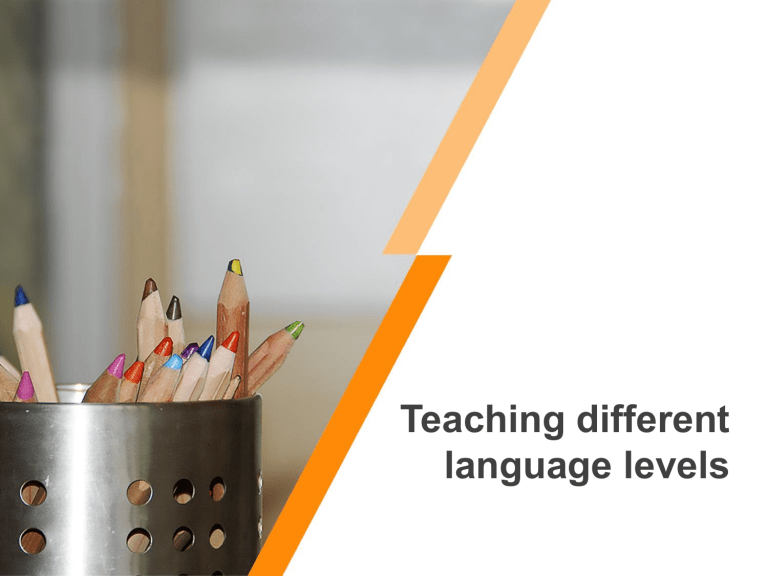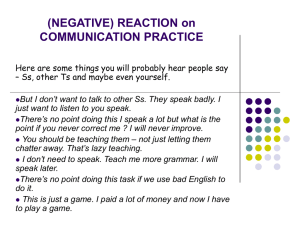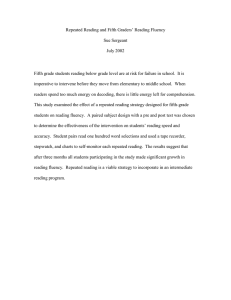
Teaching different language levels Teaching different levels Modern approach to language learning and teaching • Based on the notion of communicative proficiency – the increasing ability to communicate and operate effectively in the target language • Skills-based (Can Do statements) • Communicative purpose (what people can do) – rather than on specific linguistic knowledge • Exam-oriented Teaching different levels Common European Framework of Reference: Proficient User C2 Mastery C1 Proficiency Independent User B2 Vantage B1 Threshold Basic User A2 Waystage A1 Breakthrough Teaching different levels Global Scale: A: Basic User B: Independent User C: Proficient User 1. 2. 3. Can produce clear, detailed text on a wide range of subjects and explain a viewpoint on a topical issue giving the advantages and disadvantages of various options. Can interact in a simple way provided the other person talks slowly and clearly and is prepared to help. Can express him/herself spontaneously, very fluently and precisely, differentiating finer shades of meaning even in more complex situations. Teaching different levels Global Scale: Teaching different levels Global Scale: Teaching different levels Global Scale: Teaching different levels Teenagers Exams: Cambridge English VS Russian National Teaching different levels Teaching across proficiency levels: Placement test: False beginners A1 Beginners A1-A2 Elementary A2 Pre-intermediate A2-B1 Intermediate B1-B2 Upper-intermediate B2-C1 Advanced C1 Proficient C2 Teaching different levels Teaching beginning levels: Teaching beginners is considered to be the most challenging as the students have little or no prior knowledge of the target language and the teacher (and techniques and materials) becomes a central determiner in whether students accomplish their goals. The target language can be taught directly, though students’ capacity for taking in and retaining new words, structures, and concepts is limited. Presentation of material should be in simple segments not to overwhelm students. Teaching different levels Teaching beginning levels: 1. Students’ cognitive learning processes (language learning is in focal, controlled mode repetition of limited number of words, phrases and sentences, coax into peripheral processing use practiced language for meaningful purposes) 2. The role of the teacher (teacher-centred class, introduce group and pair work student-centred class) 3. Teacher talk (slow speech, clear articulation, native language is possible) 4. Authenticity of language (authentic language, short simple phrases) 5. Fluency and accuracy (fluency is a goal for short segments, free and open practice without fear of being corrected, correct selected grammatical and phonological errors, pronunciation work is important) Teaching different levels Teaching beginning levels: 6. Student creativity (can be creative only within the confines of a highly controlled repertoire of language) 7. Techniques (short, simple, mechanical: choral repetition, drilling, teacher-initiated questions, structured and clearly defined group/pair activities, a variety of techniques) 8. Listening and speaking goals (meaningful and authentic communication tasks, variety of functions, limited language) 9. Reading and writing goals (brief real-life written materials: ads, recipes, forms, simple notes, letters) 10. Grammar (simple verb forms, personal pronouns, definite/indefinite articles, singular/plural nouns, simple sentences, progression from simple to complex, native language is possible) Teaching different levels Teaching intermediate levels: Students have progressed to an ability to sustain basic communicative tasks, to establish some minimal fluency, to deal with a few unrehearsed situations, to self-correct on occasion, to use a few compensatory strategies and to “get along” in the language beyond mere survival. Teaching different levels Teaching intermediate levels: 1. Students’ cognitive learning processes (automatic processing takes hold) 2. The role of the teacher (students should be encouraged to initiate, student-student interaction, small groups and whole-class activities, learner-centred work, mixed-ability groups) 3. Teacher talk (natural pace, clear articulation, native language is minimum, TTT (teacher-talking time) ~ 50 %) 4. Authenticity of language (authentic real language) 5. Fluency and accuracy (reasonable balance between accuracy and fluency, individual approach, saying or writing a steady flow of language for a short time without self- or other- correction is a must) Teaching different levels Teaching intermediate levels: 6. Student creativity (can be creative, interlanguage errors are a good implication of the creative application) 7. Techniques (common interactive: chain stories, surveys and polls, paired interviews, group problem-solving, role-plays, storytelling, etc.) 8. Listening and speaking goals (creation of novel utterances, participation in short conversations, asking and answering questions, paraphrasing, the functions are not complex, but the forms students use are) 9. Reading and writing goals (reading materials are complex in terms of length, grammar and discourse, skimming and scanning skills, paragraphs and short stories, writing is more sophisticated 10. Grammar (progressive verb tenses and causes, simple explanations in target language) Teaching different levels Teaching advanced levels: Students move up the developmental ladder, getting closer to their goals, developing fluency along with a greater degree of accuracy, able to handle virtually any situation in which target language is demanded. They reach “superior level”, comparable in most aspects to an educated native-speaker level. Teaching different levels Teaching advanced levels: 1. Students’ cognitive learning processes (focal attention is given to interpretation and negotiation of meaning and to the conveying of thoughts and feelings in interactive communication, teacher assists in automatizing language) 2. The role of the teacher (predominantly learner-centred classroom, directive role orderly plan) 3. Teacher talk (natural (proficient) language at natural speed, systematic feedback) 4. Authenticity of language (authentic language, academic, literature) 5. Fluency and accuracy (rare errors, peer/teacher correction) Teaching different levels Teaching advanced levels: 6. Student creativity (able to apply classroom material to real contexts beyond) 7. Techniques (full range of sociolinguistic and pragmatic competencies: group debates and argumentation, complex role-plays, determining and questioning author’s intent, writing essays and critiques) 8. Listening and speaking goals (students fine-tune their production and comprehension in terms of style, register, the status of the interlocutor, the specific context of a conversational exchange, turntaking, topic nomination and termination, topic changing and cultural constraints) 9. Reading and writing goals (critical reading, interpreting written texts, skimming and scanning skills, writing professional documents) 10. Grammar (strategic competence, well-targeted deductive grammar)


